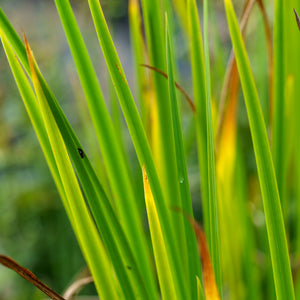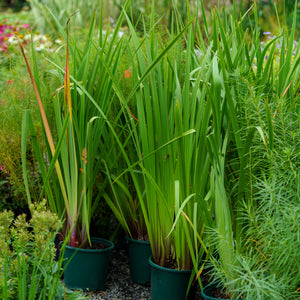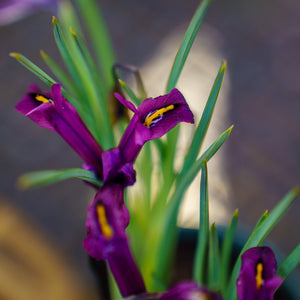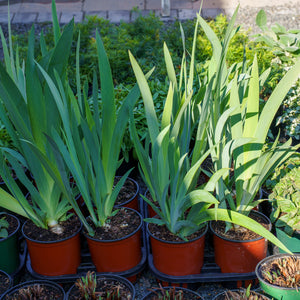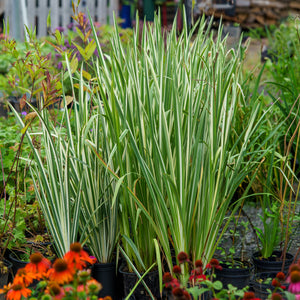The Iris Guide
Iris, with its striking blooms and elegant form, adds a touch of sophistication and vibrant color to any garden landscape. Known for their distinctive, sword-like leaves and intricate flowers, irises are perfect for creating focal points in borders, beds, and water gardens. Their blooms come in a wide range of colors, from deep purples and blues to bright yellows and whites, making them a favorite among gardeners looking to add bold and dynamic elements to their garden designs. Whether you're seeking to create a classic cottage garden or a modern, minimalist landscape, irises offer a versatile and reliable solution. With minimal maintenance requirements and adaptability to different soil types and light conditions, irises are a hassle-free addition to any garden. Explore our Iris Guide to learn more about cultivating and caring for these enchanting perennials, and discover how to incorporate them into your garden for lasting beauty and enjoyment.
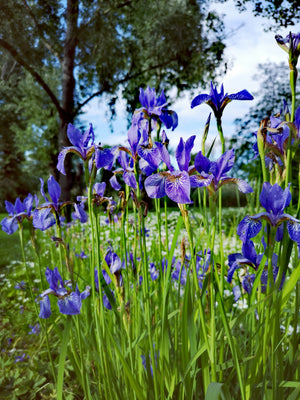
About
Iris, a genus within the Iridaceae family, is renowned for its stunning and diverse blooms that bring vibrant color and elegance to garden landscapes. Named after the Greek goddess of the rainbow, Iris flowers come in an extensive palette of colors, including purples, blues, yellows, whites, and pinks. These perennials are beloved for their intricate, often frilled or bearded flowers and their tall, sword-like foliage.
Irises are native to temperate regions across the Northern Hemisphere, including Europe, Asia, and North America. They thrive in a variety of habitats, from meadows and woodlands to riverbanks and deserts, showcasing their remarkable adaptability. The genus Iris includes a wide range of species, each with unique characteristics, such as the bearded iris (Iris germanica), Siberian iris (Iris sibirica), and Japanese iris (Iris ensata).
Irises typically bloom in late spring to early summer, providing a burst of color when many other perennials have yet to reach their peak. Their flowers are not only visually striking but also attract pollinators like bees and butterflies, contributing to garden biodiversity.
These hardy perennials prefer well-drained soil and can thrive in full sun to partial shade, depending on the species. Irises are relatively low-maintenance, requiring minimal care once established. Their rhizomatous or bulbous root systems allow them to spread and naturalize, making them excellent for creating mass plantings or filling in garden beds.
Explore the captivating world of irises in our comprehensive guide, where you'll find insights into planting techniques, care practices, and creative ways to incorporate these versatile and beautiful plants into your garden. Whether you're enhancing borders, adding color to water gardens, or creating eye-catching focal points, irises offer endless possibilities for enriching your outdoor space.
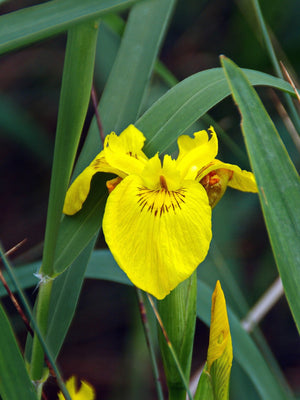
Planting
Iris plants require specific planting conditions to ensure their successful establishment and flourishing growth. Here are some essential guidelines for planting and caring for irises:
Soil: Irises thrive in well-drained soil with a pH level ranging from 6.0 to 7.0. Prepare the planting site by loosening the soil and incorporating organic matter such as compost or well-rotted manure. Good drainage is crucial, as irises are prone to rot in waterlogged conditions.
Sunlight: Irises prefer full sun to partial shade. Choose a location with at least six hours of direct sunlight per day for optimal blooming. In hotter climates, some afternoon shade can help protect the plants from intense sunlight.
Watering: Adequate watering is essential, especially during the initial growth stages. After planting, water the irises deeply to ensure the roots receive sufficient moisture. Maintain consistent soil moisture, particularly during dry periods, but avoid waterlogging, which can lead to root rot.
Mulching: Apply a thin layer of organic mulch around the base of your iris plants to retain moisture, suppress weed growth, and regulate soil temperature. Use materials like wood chips, bark, or compost, ensuring the mulch is kept a few inches away from the plant rhizomes to prevent rot.
Spacing: Plant irises 12 to 24 inches apart, depending on the variety and their mature size. Proper spacing ensures adequate air circulation and reduces the risk of fungal diseases.
Planting Time: The best time to plant irises is in late summer to early fall, giving them time to establish roots before winter. Spring planting is also possible, but it may delay flowering until the following season.
Depth: When planting bearded irises, ensure the top of the rhizome is just above or level with the soil surface. Planting too deeply can hinder blooming. For bulbous irises, plant the bulbs at a depth of about 4-6 inches.
By following these planting and care instructions, you can ensure the successful establishment and thriving growth of your iris plants. With proper attention, irises will bring vibrant color and sophisticated beauty to your garden, enhancing its charm and appeal for years to come.
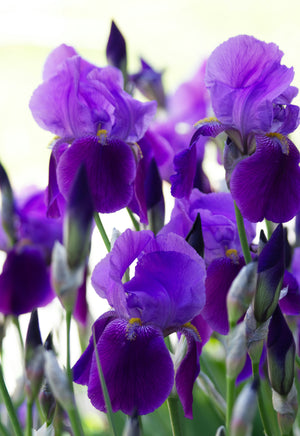
Care
Irises require specific care to ensure their optimal growth and health. Here are some general guidelines for the care of irises:
Watering: During the growing season, provide regular watering to your iris plants. Aim to keep the soil consistently moist but not waterlogged. Water deeply at the base of the plant to encourage deep root growth and to prevent fungal diseases. Reduce watering after the flowering period, as irises prefer drier conditions in the dormant phase.
Pruning: Irises generally require minimal pruning. After the flowering season, remove spent blooms to prevent seed formation and encourage energy to be redirected to the rhizomes or bulbs. In late fall, cut back the foliage to about 6 inches above the ground to reduce the risk of pests and diseases overwintering in the garden.
Fertilizing: Fertilizing can help boost the growth and blooming of irises. Apply a balanced, low-nitrogen fertilizer in early spring when new growth begins and again after the flowering period. Avoid over-fertilizing, as excessive nitrogen can lead to lush foliage growth at the expense of flowers.
Soil and Sunlight: Ensure that irises are planted in well-drained soil with a pH level ranging from 6.0 to 7.0. Irises thrive in full sun to partial shade, with at least six hours of direct sunlight daily for optimal blooming. Amend heavy clay soils with organic matter to improve drainage.
Mulching: Apply a thin layer of organic mulch around the base of your irises to retain moisture, suppress weed growth, and regulate soil temperature. Use materials like wood chips, bark, or compost, ensuring the mulch does not touch the rhizomes directly to prevent rot and fungal issues.
Pests and Diseases: Irises are generally resistant to pests and diseases, but they can occasionally encounter issues such as iris borers, aphids, or fungal infections like leaf spot and rhizome rot. Inspect your plants regularly and treat any infestations promptly with appropriate organic or chemical controls.
Dividing: Irises benefit from occasional division to maintain vigor and prevent overcrowding. Divide the plants every 3-4 years in late summer to early fall, after flowering has finished. Dig up the clumps, separate the healthy rhizomes or bulbs, and replant them at the same depth as the original plant.
Winter Care: In colder climates, protect your irises from harsh winter conditions by applying a layer of mulch to insulate the roots. Remove any debris from around the plants in the fall to reduce the risk of pests and diseases overwintering in the garden.
By following these care guidelines, your iris plants will thrive and add vibrant color and sophisticated beauty to your garden for years to come. With their resilience, low maintenance requirements, and stunning flowers, irises are a valuable addition to any landscape, providing year-round interest and charm.
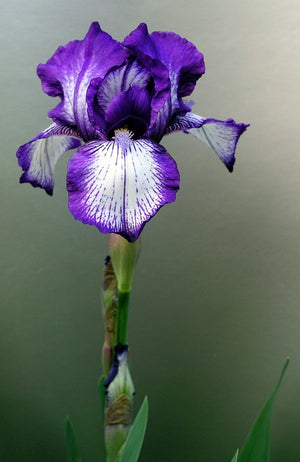
How To Use
Irises offer versatility and can be utilized in various ways to enhance your landscape. Here are some recommendations based on their characteristics:
Colorful Borders: Use irises to create vibrant borders in your garden. Plant them in clusters along pathways or garden beds to add splashes of color and texture. Their tall, sword-like leaves and striking blooms create a dramatic effect when planted in masses.
Focal Points: Irises make excellent focal points in garden design. Plant them in prominent locations where their bold flowers can be fully appreciated. Use them to draw attention to specific areas, such as entryways, garden corners, or water features.
Pollinator Gardens: Due to their attractive flowers, irises are great for pollinator gardens. Plant them alongside other pollinator-friendly plants to create a thriving ecosystem that supports bees, butterflies, and other beneficial insects.
Water Gardens: Some iris species, such as the Japanese iris (Iris ensata) and Louisiana iris (Iris hexagona), thrive in moist conditions and can be planted around ponds, streams, or water gardens. Their love for wet environments makes them perfect for adding color and texture to aquatic landscapes.
Rock Gardens: Dwarf irises and other compact varieties are well-suited for rock gardens. Plant them among rocks or gravel to create a colorful and low-maintenance landscape feature. Their unique forms and bright flowers add visual interest to rocky areas.
Mixed Perennial Beds: Incorporate irises into mixed perennial beds for continuous seasonal interest. Pair them with other early-blooming perennials like peonies, daylilies, and alliums to create a dynamic and visually appealing garden composition.
Containers: Some irises, especially dwarf and intermediate varieties, can be grown in containers. Plant them in pots to add height and color to patios, balconies, or entryways. Ensure the containers have good drainage to prevent waterlogging.
Cottage Gardens: Irises fit perfectly into cottage garden designs, where their informal, natural look blends well with other traditional garden plants. Combine them with roses, delphiniums, and foxgloves for a charming, old-fashioned garden.
Seasonal Displays: Use irises in seasonal displays to create stunning visual effects. Their diverse color palette allows for beautiful combinations that change with the seasons, adding excitement and variety to your garden.
Ground Covers: Some smaller iris species, like the dwarf crested iris (Iris cristata), can be used as ground covers. Plant them in shaded or partially shaded areas to cover the ground with their attractive foliage and delicate flowers.
When incorporating irises into your landscape, consider their growth habits, sunlight requirements, and soil preferences. By choosing the right placement and utilizing their versatile nature, iris plants can enhance the beauty and functionality of your outdoor space, providing year-round interest and vibrant blooms.
Conclusion
Irises are a captivating and versatile addition to any garden landscape. With their striking blooms, elegant foliage, and adaptability to various growing conditions, these hardy perennials bring vibrant color and sophistication to your outdoor space. Their ease of care and wide range of varieties make them a favorite among gardeners of all levels. By adhering to proper planting and maintenance techniques, you can fully harness the potential of irises to elevate your garden and make a lasting impact.
Whether you seek to create colorful borders, eye-catching focal points, or serene water gardens, irises can fulfill a variety of roles in your landscape design. Plant them individually to showcase their unique beauty, or cluster them together for a dramatic visual display. Irises' adaptability also makes them ideal for rock gardens, containers, and mixed perennial beds.
Beyond their ornamental value, irises contribute to the biodiversity of your garden ecosystem by attracting pollinators during their blooming season. Their low maintenance requirements and year-round interest make them an excellent choice for sustainable gardening. With their enduring beauty, versatility, and ecological significance, irises bring delight and natural allure to your outdoor environment, enriching your gardening experience and enhancing the overall beauty of your landscape.

